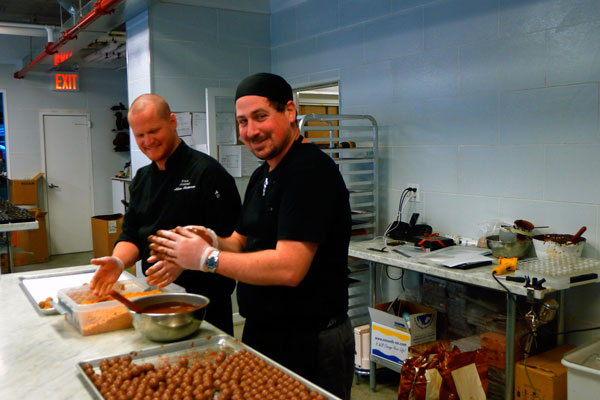
BY HEATHER DUBIN | The Fika chocolate factory in Tribeca is a whirl of confectionary activity. Christmas is around the corner, and the workers — prominently visible behind floor-to-ceiling glass windows at the 450 Washington St. location — are feeling the crunch.
Earlier this week, master chocolatier Hakan Martensson took a break from his busy schedule assembling prize-winning truffles, marzipan Santas and chocolate ornaments, to talk about Fika and its expansion.
On Monday, Martensson and his crew put together eight orders with about 700 to 800 truffles in each.
“I feel like I’m here 24 hours a day lately,” he said.
While it was difficult for him to gauge, Martensson estimates they regularly produce thousands upon thousands of truffles per week, and the holiday season substantially increases the number. But Fika, a coffee, pastry and chocolate chain, delivers more than that, and is also a purveyor of jams and seasonal spreads.
“We don’t just want to be truffles,” Martensson said. However, there is no denying that his expertise is in all things chocolate.
Originally from Hanaskog, a small town in southern Sweden with a population of 1,250, he left home at 18 for Stockholm.
Martensson, 31, trained as a pastry chef at Osterng, and became a chocolatier on his own. He then worked as a chocolatier at NK, which, according to Martensson, is the Swedish equivalent of Bergdorf Goodman.
“I became a pure chocolatier in 2003, when I decided not to make pastries again,” he said. This move later landed him on the Swedish Culinary Team, which won a gold medal in the Culinary World Cup in Luxembourg, 2006, and earned him a gold medal at the Culinary Olympics for chocolate sculpting in 2008.
“I only focus on chocolate products,” he said. “I love chocolate. You can form it in any kind of way — there’s symmetry to it.”
Martensson started creating chocolate sculptures in 2003, and learned freehand.
“I didn’t know I had the skill, and I still don’t,” he said with a laugh.
On a table, a dragon, which took him four days to make for the New York Chocolate Show, was perched next to chocolate skulls and gnomes. He likes to make fantasy/ science fiction-inspired sculptures.
“It keeps people’s interest, and it’s mine,” he said.
A large one-foot-high slab of chocolate resembling a looming woman stands at the other end of the table. It took Martensson 20 minutes just to create its base, and he had to abandon the project as holiday orders come first. He is unsure of what it will be, but Martensson thinks the piece may turn into an “Aztec Mayan” figure.
Temperature is crucial, and if it is too warm, his work instantly melts. Martensson makes sculptures for shows, book releases and special events.
“People have the craziest ideas,” he said.
His best idea may have been to come to Manhattan to join Lars Akerlund, the founder of Fika and his business partner. Martensson rattled off his exact arrival date, Jan. 16, 2009. He has been with Fika ever since.
The Tribeca location, their only chocolate facility, is the brand’s fifth store. Martensson was previously at the Pearl St. shop, which was flooded by Hurricane Sandy, where he worked in a much smaller space.
It took the Pearl St. store six months to recover from Sandy. Meanwhile, the Tribeca outlet, slated to open a month after the hurricane hit, needed an additional four months of repairs. Three feet of water ruined the cafe, and the counter space and all the machines had to be replaced.
“The money ran out,” Martensson said. “It initially took two months to fix, and then we realized there was damage in some walls. Now, everything is rising up again. That’s New York.”
The staff at the Tribeca Fika includes one full-time employee, one part-timer, two interns, a packager and a driver. They fill wholesale orders to 35 stores, such as Whole Foods Market, Dean & DeLuca and the Gansevoort Hotel, plus customized online requests.
The partners have recently signed eight more contracts, and will be opening new Fikas from the Upper West Side and Upper East Side to Bryant Park, all at the same time.
He noted, “4 World Trade Center — we were the first tenant to sign the document.”
The partners have high expectations and goals.
“On March 2015, when the World Trade Center opens, we have to build stores as the fastest-expanding coffee chain in New York City,” he said.
After they have taken Manhattan, the partners want to expand to Washington, D.C., Chicago and Los Angeles.
“We have all the keys to get where we want,” Martensson said. “We just aren’t there yet, but every week we take the steps to get there.”
His award-winning chocolate might help them attain their aspirations. This November, Martensson won the International Chocolate Awards in London for his Gianduja — sweet chocolate with mixed nuts. His creation includes hazelnut and caramelized quinoa. Martensson beat out 200 American companies in the first national round.
While he is happy about the win, Martensson is more concerned with developing a higher-quality product, as well as fostering awareness about chocolate. His products are all handmade, with the exception of the machine that melts the chocolate. Most of his chocolate comes from South America, Madagascar and Ghana.
Truffles take three days to make, and range from cinnamon with Tabasco to gingerbread to salted caramel.
“I’m playing with a lot of different flavors, mostly Scandinavian,” he said.
The goat cheese truffle, which is a Norwegian brown cheese combined with white chocolate and a little bit of sea salt, is extremely popular.
“I never get sick of chocolate,” Martensson said. “I don’t have a job. I have a lifestyle.”

















